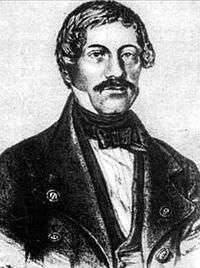Naum Veqilharxhi
 | |
| Born |
Naum Bredhi December 6, 1797 Vithkuq, Korçë southern Albania |
| Died | 1854[1] (Aged 57) |
| Occupation | lawyer |
| Language | Albanian |
| Ethnicity | Albanian |
| Notable works | Evëtor |
Naum Veqilharxhi born Naum Bredhi (1797-1854[1]) was an Albanian lawyer and scholar. In 1844, he created a unique alphabet for the Albanian language using characters he had created himself, the Vithkuqi script. Veqilharxhi is one of the most prominent figures of the early Albanian National Awakening, and is considered by Albanians as its first ideologue.[2][3]
Life
Naum Veqilharxhi was born Naum Bredhi in 1797 in the village of Vithkuq, near Korçë southern Albania. His father Panajot Bredhi was a steward of Ali Pashë Tepelena, the ruler of the Pashalik of Janina. At an early age Veqilharxhi migrated to Romania to study law. As a student he took part in the Wallachian uprising of 1821. A few years later he worked in Brăila as a lawyer, became wealthy and used his money to promote the ideas of the Albanian National Awakening.[4] In Brăila he joined an intellectual organization of Albanians, who considered the development of Albanian language and culture necessary for the Albanian National Awakening.[4]
In 1825, he started the creation of his alphabet of the Albanian language. The final version of his thirty-three-letter Vithkuqi alphabet, whose characters were invented by Veqilharxhi, was printed as part of primer in 1844-5 titled Evëtori Shqip Fort i Shkurtër (English: The most Useful and Concise Albanian Alphabet).[5] Veqilharxhi avoided the use of Latin, Greek or Arabic alphabets and characters because of their religious associations and divisions.[6] Veqilarxhi's Evëtor first distributed in Korçë and later westwards as far as Berat, where it reached great success.[7] On April 22, 1845 Athanas Paskali, one of the notable people of Korçë, along with others sent him a letter requesting as many more copies as possible.[7]
In 1845 Veqilharxhi sent a polemic open letter written in the Greek language to his nephew, who had dared call his patriotic ideas chimera: the letter is considered to be one of the first written documents to record the main ideas of the Albanian National Awakening movement.[8]
References
- 1 2 Islami, Selim (1984). "4". Historia e Shqiperise (in Albanian). 2. Academy of Sciences of Albania. p. 134.
- ↑ Enis Sulstarova, Naum Veqilharxhi dhe lindja e kombit [Naum Veqilharxhi and the birth of the nation] (in Albanian), Pashtriku, retrieved 2014-12-01,
Naum Veqilharxhi is considered the avant-garde and first ideologue of the National Awakening, because his work results in one of the first attempts for an original Albanian alphabet (1844 and 1845), as well as contains an embryo form of the ideas which would develop later on during the National Renaissance. [Naum Veqilharxhi është konsideruar si pararendësi dhe ideologu i parë i Rilindjes Kombëtare Shqiptare, sepse vepra e tij përbën një nga përpjekjet e para për një alfabet origjinal të shqipes (1844 dhe 1845), si edhe përmban në trajtë embrionale idetë që do të zhvilloheshin më vonë gjatë periudhës së Rilindjes.]
- ↑ Fedhon Meksi (2011-10-21), Naum Veqilharxhi, babai i alfabetit dhe abetares shqipe. [Naum Veqilharxhi, the father of Albanian alphabet and ABC-book] (in Albanian), retrieved 2014-12-01
- 1 2 Treptow, Kurt (1992). From Zalmoxis to Jan Palach: studies in East European history. East European monographs. 328. East European Monographs. p. 98. ISBN 0-88033-225-5.
- ↑ Norris, H.T (1993). Islam in the Balkans: religion and society between Europe and the Arab world. University of South Carolina Press. p. 247. ISBN 0-87249-977-4.
- ↑ Straehle, Carolin (1974). International journal of the sociology of language. Mouton. p. 5.
- 1 2 Michelson, Paul (2002). National development in Romania and southeastern Europe. Center for Romanian Studies. p. 54. ISBN 973-9432-37-9.
- ↑ Islami, p.137